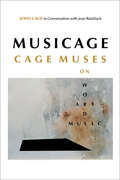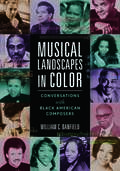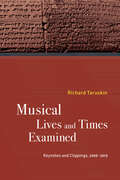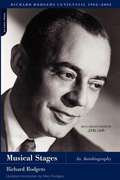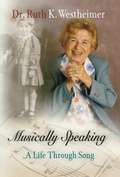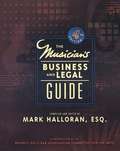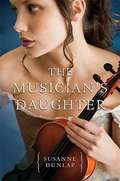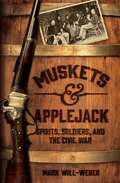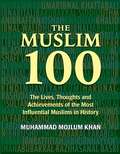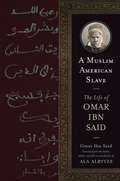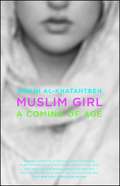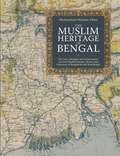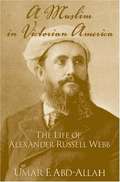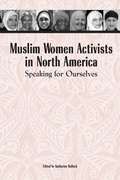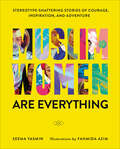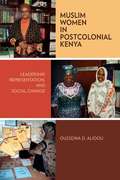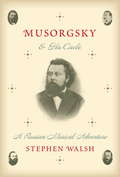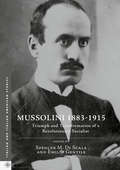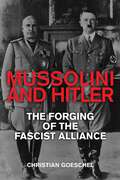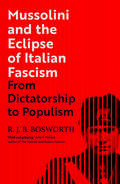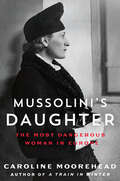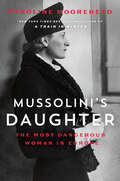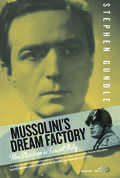- Table View
- List View
Musicage: Cage Muses on Words, Art, Music
by Joan Retallack John Cage"I was obliged to find a radical way to work -- to get at the real, at the root of the matter," John Cage says in this trio of dialogues, completed just days before his death. His quest for the root of the matter led him beyond the bounds of the conventional in all his musical, written, and visual pieces. The resulting expansion of the definition of art -- with its concomitant emphasis on innovation and invention -- earned him a reputation as one of America's most influential contemporary artists. Joan Retallack's conversations with Cage represent the first consideration of his artistic production in its entirety, across genres. Informed by the perspective of age, Cage's comments range freely from his theories of chance and indeterminate composition to his long-time collaboration with Merce Cunningham to the aesthetics of his multimedia works. A composer for whom the whole world -- with its brimming silences and anarchic harmonies -- was a source of music, Cage once claimed, "There is no noise, only sounds." As these interviews attest, that penchant for testing traditions reached far beyond his music. His lifelong project, Retallack writes in her comprehensive introduction, was "dislodging cultural authoritarianism and gridlock by inviting surprising conjunctions within carefully delimited frameworks and processes." Consummate performer to the end, Cage delivers here just such a conjunction -- a tour de force that provides new insights into the man and a clearer view of the status of art in the 20th century.
Musical Landscapes in Color: Conversations with Black American Composers (Music in American Life)
by William C. BanfieldNow available in paperback, William C. Banfield’s acclaimed collection of interviews delves into the lives and work of forty-one Black composers. Each of the profiled artists offers a candid self-portrait that explores areas from training and compositional techniques to working in a exclusive canon that has existed for a very long time. At the same time, Banfield draws on sociology, Western concepts of art and taste, and vernacular musical forms like blues and jazz to provide a frame for the artists’ achievements and help to illuminate the ongoing progress and struggles against industry barriers. Expanded illustrations and a new preface by the author provide invaluable added context, making this new edition an essential companion for anyone interested in Black composers or contemporary classical music. Composers featured: Michael Abels, H. Leslie Adams, Lettie Beckon Alston, Thomas J. Anderson, Dwight Andrews, Regina Harris Baiocchi, David Baker, William C. Banfield, Ysaye Maria Barnwell, Billy Childs, Noel DaCosta, Anthony Davis, George Duke, Leslie Dunner, Donal Fox, Adolphus Hailstork, Jester Hairston, Herbie Hancock, Jonathan Holland, Anthony Kelley, Wendell Logan, Bobby McFerrin, Dorothy Rudd Moore, Jeffrey Mumford, Gary Powell Nash, Stephen Newby, Coleridge-Taylor Perkinson, Michael Powell, Patrice Rushen, George Russell, Kevin Scott, Evelyn Simpson-Curenton, Hale Smith, Billy Taylor, Frederick C. Tillis, George Walker, James Kimo Williams, Julius Williams, Tony Williams, Olly Wilson, and Michael Woods
Musical Lives and Times Examined: Keynotes and Clippings, 2006–2019
by Richard TaruskinIn this new and final collection, Richard Taruskin gathers a sweeping range of keynote speeches, reviews, and critical essays from the first twenty years of the twenty-first century. With twenty-three essays in total, this volume presents five lectures delivered in Budapest on Hungarian music and ten essays on Russian music. Reviews of contemporary work in musicology and reflections on the place of music in society showcase Taruskin’s trademark wit and breadth. Musical Lives and Times Examined is an essential collection, a comprehensive portrait of a distinguished figure in music studies, illuminating the ideas that have transformed the discipline and will continue to do so.
Musical Stages: An Autobiography
by Richard RodgersRichard Rodgers was one of the most successful, prolific composers of the last century. His songs are as well known today as when he created them more than 50 years ago, for musicals such as South Pacific, Pal Joey, Carousel, the King and I, The Sound of Music and Oklahoma! At 16 he began a long working relationship with the brilliant but tormented lyricist Lorenz hart and then went on to collaborate for another 20 years with the sturdier and equally inspired Oscar Hammerstein II. Late in his extraordinary life, Rodgers wrote what has sine become a celebrated autobiography and a classic of the theatre world, Musical Stages.
The Musical Work of Nadia Boulanger
by Jeanice BrooksNadia Boulanger - composer, critic, impresario and the most famous composition teacher of the twentieth century UO was also a performer of international repute. Her concerts and recordings with her vocal ensemble introduced audiences on both sides of the Atlantic to unfamiliar historical works and new compositions. This book considers how gender shaped the possibilities that marked Boulanger's performing career, tracing her meteoric rise as a conductor in the 1930s to origins in the classroom and the salon. Brooks investigates Boulanger's promotion of structurally motivated performance styles, showing how her ideas on performance of historical repertory and new music relate to her teaching of music analysis and music history. The book explores the way in which Boulanger's musical practice relied upon her understanding of the historically transcendent masterwork, in which musical form and meaning are ideally joined, and show how her ideas relate to broader currents in French aesthetics and culture. "
Musically Speaking
by Dr Ruth K. Westheimer"Music, I have come to realize, is for me a kind of golden thread running through my life. It has helped maintain my connection with the past that otherwise might have been severed by catastrophe and time. I am often asked--indeed, I often wonder myself--why it is that I should always have had such joie de vivre in the face of the losses and dislocations I had to endure in my early years. The answer I always gave was that the warmth and security of my early childhood had a remarkable power and influence. This is certainly true. But now I have realized that there is another part to the answer. And that is music."--from the introductionWho among us does not have a song that triggers vivid memories--of jubilation, of belonging, of sorrow, of love? In Musically Speaking, Dr. Ruth K. Westheimer, one of America's most beloved personalities, has written a warm and contemplative book about the role music has played in her life and the ineradicable traces it has left on her thoughts, emotions, her very being.In this memoir through song, Dr. Ruth invites us to share her story from a uniquely musical perspective. By the time she was thirty, Ruth Westheimer had lived in five countries, each with a distinctive musical culture, each with a different hold on her sensibility. For the first ten years of her life, the comforting melodies of childhood helped drown out the anthems of Nazism to be heard elsewhere in her native Germany; as an adolescent refugee in Switzerland, she came to be aware that, however loudly she sang the patriotic songs of the land that gave her shelter, she could never truly be at home there.Present at the creation of the modern state of Israel, she sang and danced to the new music of a new nation; as a young woman eagerly absorbing all that Paris had to offer in the way of romance and worldliness in the early 1950s, the songs of Edith Piaf, Mouloudji, and Yves Montand were her tutors. An almost accidental emigration to America brought new challenges and new stability, as she became a wife, mother, and professional; tremendous and unforeseen celebrity came later, and with it the giddy opportunity to indulge her love of music as never before.Always, the classical repertoire of Mozart, Haydn, Beethoven, and Brahms has drawn Westheimer to a German culture that has belonged--and not belonged--to her throughout her life. And always, the music of the Jewish tradition has given her strength and comfort beyond words.Affording a view of Dr. Ruth from a rare private vantage point, Musically Speaking offers wondrous testimony to the resilience of the human spirit. This is a book full of color, verve, humor, and wisdom, unfolding gracefully through the beloved music of the Jewish holidays, the lullabies of childhood, the songs that sustained an orphan and roused the courage of a young woman, the melodies that enable a widow grieving for her husband to recall, from deep within the years of love, companionship, and happiness.
The Musician's Business and Legal Guide
by Mark HalloranWritten specifically for musicians by legal and business experts in the music industry, this text covers nearly all of the confusing business and legal situations musicians find themselves in on the way to and through a professional career. It focuses on issues as they are actually practised with clause-by-clause commentaries on almost all the major music industry contracts.
The Musician's Daughter
by Susanne DunlapAmid the glamour of Prince Nicholas Esterhazy's court in 18th-century Vienna, murder is afoot. Or so 15-year-old Theresa Maria thinks after her musician father turns up dead on Christmas Eve. Her father's mentor, the acclaimed composer Franz Joseph Haydn, offers her insight into her father's secret life.
Muskets and Applejack: Spirits, Soldiers, and the Civil War
by Mark Will-Weber"I wish some of you would tell me the brand of whiskey that Grant drinks. I would like to send a barrel of it to my other generals."- President Abraham Lincoln, when confronted about General Ulysses Grant's excessive drinking.Blood, gunfire, and whiskey: they are the three things that defined Civil War battlefields. In this fascinating, booze-drenched history of the war that almost tore America apart, historian Mark Will-Weber (author of Mint Juleps with Teddy Roosevelt) weaves together lighthearted stories of drunken generals and out-of-control soldiers with the gritty reality of battlefields where whiskey was the only medicine-and sometimes the only food.Muskets and Applejack paints a full, complex picture of the surprisingly large role alcohol played in the Civil War: how it helped heal physical and emotional wounds, form friendships, and cause strife. Interspersed between stories from the battlefield are authentic recipes of soldiers' favorite drinks-from both sides of the Mason-Dixon line.
The Muslim 100
by Muhammad Mojlum Khan"It is rare to see a publication which includes personalities from both Shia and Sunni schools of thought and which is so much needed in today's turbulent world. This book, I believe will . . . enrich our understanding of not only the historical but the contemporary history of the Muslim."--Ahmed J. Versi, chief editor of The Muslim News (London)Who have been the Muslim world's most influential people? What were their ideas, thoughts, and achievements? In one hundred short and engaging profiles of these extraordinary people, fourteen hundred years of the vast and rich history of the Muslim world is unfolded. For anyone interested in getting an intimate view of Islam through its kings and scholars, generals and sportsmen, architects and scientists, and many others--this is the book for you.Among those profiled are the Prophet Muhammad, the Caliph Umar, Imam Husain, Abu Hanifa, Harun al-Rashid, al-Khwarizmi, al-Ghazali, Saladin, Rumi, Ibn Battuta, Sinan, Ataturk, Iqbal, Jinnah, Ayatollah Khomeini, Malcolm X, and Muhammad Ali.
A Muslim American Slave
by Alison Liebhafsky Des ForgesBorn to a wealthy family in West Africa around 1770, Omar Ibn Said was abducted and sold into slavery in the United States, where he came to the attention of a prominent North Carolina family after filling “the walls of his room with piteous petitions to be released, all written in the Arabic language,” as one local newspaper reported. Ibn Said soon became a local celebrity, and in 1831 he was asked to write his life story, producing the only known surviving American slave narrative written in Arabic. In A Muslim American Slave, scholar and translator Ala Alryyes offers both a definitive translation and an authoritative edition of this singularly important work, lending new insights into the early history of Islam in America and exploring the multiple, shifting interpretations of Ibn Said’s narrative by the nineteenth-century missionaries, ethnographers, and intellectuals who championed it. This edition presents the English translation on pages facing facsimile pages of Ibn Said’s Arabic narrative, augmented by Alryyes’s comprehensive introduction, contextual essays and historical commentary by leading literary critics and scholars of Islam and the African diaspora, photographs, maps, and other writings by Omar Ibn Said. The result is an invaluable addition to our understanding of writings by enslaved Americans and a timely reminder that “Islam” and “America” are not mutually exclusive terms. This edition presents the English translation on pages facing facsimile pages of Ibn Said’s Arabic narrative, augmented by Alryyes’s comprehensive introduction and by photographs, maps, and other writings by Omar Ibn Said. The volume also includes contextual essays and historical commentary by literary critics and scholars of Islam and the African diaspora: Michael A. Gomez, Allan D. Austin, Robert J. Allison, Sylviane A. Diouf, Ghada Osman, and Camille F. Forbes. The result is an invaluable addition to our understanding of writings by enslaved Americans and a timely reminder that “Islam” and “America” are not mutually exclusive terms.
Muslim Girl: A Coming of Age
by Amani Al-KhatahtbehRequired reading from the founder of MuslimGirl.com--a harrowing and candid memoir about coming of age as a Muslim American in the wake of 9/11, during the never-ending war on terror, and through the Trump era of casual racism.At nine years old, Amani Al-Khatahtbeh watched from her home in New Jersey as two planes crashed into the World Trade Center on September 11, 2001. That same year, she heard her first racial slur. At age eleven, when the United States had begun to invade Iraq and the television was flooded with anti-Muslim commentary, Amani felt overwhelmed with feelings of intense alienation from American society. At thirteen, her family took a trip to her father's native homeland of Jordan, and Amani experienced firsthand a culture built on pure religion, not Islamic stereotypes. Inspired by her trip and after years of feeling like her voice as a Muslim woman was marginalized and neglected during a time when all the media could talk about was, ironically, Muslim women, Amani created a website called MuslimGirl. As the editor-in-chief, she put together a team of Muslim women and started a life dedicated to activism. This is the extraordinary account of Amani's journey through adolescence as a Muslim girl, from the Islamophobia she's faced on a daily basis, to the website she launched that became a cultural phenomenon, to the nation's political climate in the 2016 election cycle with Donald Trump as the Republican nominee. While dispelling the myth that a headscarf makes you a walking target for terrorism, she shares both her own personal accounts and anecdotes from the "sisterhood" of writers that serve as her editorial team at MuslimGirl. Amani's honest, urgent message is fresh, timely, and a deeply necessary counterpoint to the current rhetoric about the Middle East.
The Muslim Heritage of Bengal
by Muhammad Mojlum Khan"The Muslim Heritage of Bengal is a multidimensional work. . . . I am sure this book will add to the vista of knowledge in the field of Muslim history and heritage of Bengal. I recommend this work."-Dr A. K. M. Yaqub Ali, Professor Emeritus, Islamic History & Culture, University of Rajshahi"Khan's book provides invaluable information which will inspire present and future generations."-Dr M. Abdul Jabbar Beg, former professor of Islamic History and Civilization, National University of MalaysiaA popular history that covers eight hundred years of the history of Islam in Bengal through the example of forty two inspirational men and women up until the twentieth century. Written by the author of the bestselling The Muslim 100.Included are the prominent figures Shah Jalal, Nawab Abdul Latif, Rt. Hon. Syed Ameer Ali, Sir Salimullah Khan Bahadur, and Begum Rokeya.Muhammad Mojlum Khan was born in 1973 in Habiganj, Bangladesh, and was educated in England. He is a teacher, author, literary critic, and research scholar, and has published more than 150 essays and articles worldwide. He is the author of The Muslim 100 (2008). He is a Fellow of the Royal Asiatic Society of Great Britain and Director of the Bengal Muslim Research Institute, United Kindgom. He lives in England with his family.
A Muslim in Victorian America: The Life of Alexander Russell Webb
by Umar F. Abd-AllahA biography of Alexander Russell Webb, a central figure of American Islam during the late nineteenth and early twentieth centuries. A native of the Hudson Valley, he was a journalist, editor, and civil servant. Raised a Presbyterian, Webb early on began to cultivate an interest in other religions and became particularly fascinated by Islam. While serving as U.S. consul to the Philippines in 1887, he took a greater interest in the faith and embraced it in 1888, becoming one of the first Americans known to have done so. Within a few years, he began corresponding with important Muslims in India. Webb became an enthusiastic propagator of the faith, founding the first Islamic institution in the United States: the American Mission. He wrote numerous books intended to introduce Islam to Americans, started the first Islamic press in the United States, published a journal entitled the Modern World, and served as the representative of Islam at the 1893 World's Parliament of Religions in Chicago. In 1901, he was appointed Honorary Turkish Consul General in New York and was invited to Turkey, where he received two Ottoman medals of merit. In this first-ever biography of Webb, Umar F. Abd-Allah examines Webb's life and uses it as a window through which to explore the early history of Islam in America. Except for his adopted faith, every aspect of Webb's life was, as Abd-Allah shows, quintessentially characteristic of his place and time. It is because he was so typically American that he was able to serve as Islam's ambassador to America (and vice versa).
Muslim Women Activists in North America: Speaking for Ourselves
by Katherine BullockIn the eyes of many Westerners, Muslim women are hidden behind a veil of negative stereotypes that portray them as either oppressed, subservient wives and daughters or, more recently, as potential terrorists. <P><P>Yet many Muslim women defy these stereotypes by taking active roles in their families and communities and working to create a more just society. This book introduces eighteen Muslim women activists from the United States and Canada who have worked in fields from social services, to marital counseling, to political advocacy in order to further social justice within the Muslim community and in the greater North American society.
Muslim Women Are Everything: Stereotype-Shattering Stories of Courage, Inspiration, and Adventure
by Seema YasminWinner of the 2021 International Book Awards Winner of American Book Fest's 2020 Best Book Awards in Women’s IssuesA full-color illustrated collection of riveting, inspiring, and stereotype-shattering stories that reveal the beauty, diversity, and strength of Muslim women both past and present.Tired of seeing Muslim women portrayed as weak, sheltered, and limited, journalist Seema Yasmin reframes how the world sees them, to reveal everything they CAN do and the incredible, stereotype-shattering ways they are doing it.Featuring 40 full-color illustrations by illustrator Fahmida Azim throughout, Muslim Women Are Everything is a celebration of the ways in which past and present Muslim women from around the world are singing, dancing, reading, writing, laughing, experimenting, driving, and rocking their way into the history books.Forget subservient, oppressed damsels—say hello to women who are breaking down barriers using their art, their voices, and their activism, including:Tesnim Sayar from Denmark, a Muslim goth-punk who wears a red tartan mohawk on top of her hijabAmerican superstar singer SZANura Afia, CoverGirl’s first hijabi ambassadorIlhan Omar and Rashida Tlaib, America’s first Muslim congresswomenIlyana Insyirah, a hijaab-wearing scuba-diving midwife from AustraliaShowcasing women who defy categorization, Muslim Women Are Everything proves that to be Muslim and a woman is to be many things: strong, vulnerable, trans, disabled, funny, entrepreneurial, burqa or bikini clad, and so much more.
Muslim Women in Postcolonial Kenya
by Ousseina D. AlidouIn education, journalism, legislative politics, social justice, health, law, and other arenas, Muslim women across Kenya are emerging as leaders in local, national, and international contexts, advancing reforms through their activism. Muslim Women in Postcolonial Kenya draws on extensive interviews with six such women, revealing how their religious and moral beliefs shape reform movements that bridge ethnic divides and foster alliances in service of creating a just, multicultural, multiethnic, and multireligious democratic citizenship. Mwalim Azara Mudira opened a school of theology for Muslim women. Nazlin Omar Rajput of The Nur magazine was a pioneer in reporting on HIV/AIDS in the Muslim community. Amina Abubakar, host of a women's radio show, has publicly addressed the sensitive subject of sexual crimes against Muslim women. Two women who are members of parliament are creating new socioeconomic and political opportunities for girls and women, within a framework that still embraces traditional values of marriage and motherhood. Examining the interplay of gender, agency, and autonomy, Ousseina D. Alidou shows how these Muslim women have effected change in the home, the school, the mosque, the media, and more--and she illuminates their determination as actors to challenge the oppressive influences of male-dominated power structures. In looking at differences as opportunities rather than obstacles, these women reflect a new sensibility among Muslim women and an effort to redefine the meaning of women's citizenship within their own community of faith and within the nation.
Musorgsky and His Circle
by Stephen WalshThe emergence of Russian classical music in the nineteenth century in the wake of Mikhail Glinka comprises one of the most remarkable and fascinating stories in all musical history. The five men who came together in the Russian capital of St. Petersburg in the 1860s, all composers of talent, some of genius, would be--in spite of a virtual lack of technical training--responsible for some of the greatest and best-loved music ever written. How this happened is the subject of Stephen Walsh's brilliant composite portrait of the group known in the West as the Five, and in Russia as moguchaya kuchka--the Mighty Little Heap. Friends, competitors, and creative intellectuals whose ambitions and ideas reflect the ferment of their times, Mily Balakirev, César Cui, Alexander Borodin, Nikolay Rimsky-Korsakov, and--most important of all--Modest Musorgsky, come wonderfully to life in this extended account.The detail is engrossing. We see Borodin composing music while conducting research in chemistry ("he would jump up and run back to the laboratory to make sure nothing had burnt out or boiled over there, meanwhile filling the corridor with improbable sequences of ninths or sevenths"); Balakirev tutoring Musorgsky ("Balakirev could not remedy the defects in his pupil's character, but he could confront him with works of genius"); Cui doggedly producing operas during breaks from his career as a military fortifications instructor. Musorgsky asserts his independence, moving from writing songs and the showpiece Night on Bald Mountain to the magnificent Boris Godunov, meanwhile struggling against poverty and depression. In the background such important figures as Vissarion Belinsky and Nikolay Chernïshevsky shape the cultural milieu, while the godfather of the kuchka, critic and scholar Vladimir Stasov, is seen offering sometimes combative support. As an experienced and widely skilled musical scholar and biographer (his two-volume life of Stravinsky has been called "one of the best books ever written about a musician"), Stephen Walsh is exceptionally wellplaced to tell this story. He does so with deep understanding and panache, making Musorgksy and His Circle both important and a delight to read.
Mussolini 1883-1915
by Spencer M. Di Scala Emilio GentileThis book describes Mussolini's little-known radical ideology, including his activities in Switzerland, relationship with revolutionary syndicalism, and radical journalism. It provides an in-depth treatment of the young Benito Mussolini as a revolutionary Socialist and describes the political maneuverings that took a major European Socialist party by storm before the First World War. It explains the process of how he came to dominate Italian Socialism until the crisis caused by Italy's intervention in World War I. It illuminates Mussolini's leadership qualities and his rise to leader of the Italian Socialist Party.
Mussolini and Hitler: The Forging of the Fascist Alliance
by Christian GoeschelThis fresh treatment of Fascist Italy and Nazi Germany reveals how the close relationship between Mussolini and Hitler influenced both men.From 1934 until 1944 Mussolini met Hitler numerous times, and the two developed a relationship that deeply affected both countries. While Germany is generally regarded as the senior power, Christian Goeschel demonstrates just how much history has underrepresented Mussolini’s influence on his German ally.A scholar of twentieth-century Germany and Italy, Goeschel revisits all of Mussolini and Hitler’s key meetings to examine how they constructed a powerful image of a strong Fascist-Nazi relationship that still resonates with the general public. His portrait of Mussolini draws on sources ranging beyond political history to reveal a leader who, at times, shaped Hitler’s decisions and was not the gullible buffoon he’s often portrayed as. The first comprehensive study of the Mussolini-Hitler relationship, this book is a must-read for scholars and anyone interested in the history of European fascism, World War II, or political leadership.
Mussolini and the Eclipse of Italian Fascism: From Dictatorship to Populism
by R. J. BosworthAn incisive account of how Mussolini pioneered populism in reaction to Hitler&’s rise—and thereby reinforced his role as a model for later authoritarian leaders On the tenth anniversary of his rise to power in 1932, Benito Mussolini (1883–1945) seemed to many the &“good dictator.&” He was the first totalitarian and the first fascist in modern Europe. But a year later Hitler&’s entrance onto the political stage signaled a German takeover of the fascist ideology. In this definitive account, eminent historian R.J.B. Bosworth charts Mussolini&’s leadership in reaction to Hitler. Bosworth shows how Italy&’s decline in ideological pre-eminence, as well as in military and diplomatic power, led Mussolini to pursue a more populist approach: angry and bellicose words at home, violent aggression abroad, and a more extreme emphasis on charisma. In his embittered efforts to bolster an increasingly hollow and ruthless regime, it was Mussolini, rather than Hitler, who offered the model for all subsequent authoritarians.
Mussolini in Ethiopia, 1919–1935
by Robert MallettMussolini in Ethiopia, 1919–1935 looks in detail at the evolution of the Italian Fascist regime's colonial policy within the context of European politics and the rise to power of German National Socialism. It delves into the tortuous nature of relations between the National Fascist Party and the National Socialist German Workers' Party (NSDAP), while demonstrating how, ultimately, a Hitler-led Germany proved the best mechanism for overseas Italian expansion in East Africa. The book assesses the emergence of an ideologically driven Fascist colonial policy from 1931 onwards and how this eventually culminated in a serious clash of interests with the British Empire. Benito Mussolini's successful flouting of the League of Nations' authority heralded a new dark era in world politics and continues to have its resonance in today's world.
Mussolini's Daughter: The Most Dangerous Woman in Europe
by Caroline MooreheadThe bestselling author of A Train in Winter returns with the definitive story of Mussolini&’s daughter, Edda, one of the most influential women in 1930s Italy, whose life had more twists and turns than a spy novel.Edda Mussolini was Benito's favourite child: spoiled and venal, uneducated but clever, faithless but flamboyant, a brilliant diplomat, wild but brave, and ultimately strong and loyal. For much of the twenty-year period of Fascist rule, she was her father's closest confidante.In 1930, at the age of nineteen, Edda married Count Galeazzo Ciano, who would become the youngest Foreign Secretary in Italian history. Acting as envoy to both Germany and Britain, Edda played a part in steering Italy to join forces with Hitler. During this time, the Cianos became the most celebrated and glamorous couple in elegant, vulgar Roman fascist society.Their fortunes turned in 1943, when Ciano voted against Mussolini in a plot to bring him down, and his father-in-law did not forgive him. Edda's dramatic story includes hidden diaries, her father's downfall and her husband's execution, and an escape into Switzerland followed by a period in exile. Moorehead draws a portrait of a complicated, bold, and determined woman—one who emerges not just as a witness but as a key player in some of the twentieth century's defining moments. And we see Fascist Italy with all its glamour, decadence and political intrigue, and the turbulence before its violent end.
Mussolini's Daughter: The Most Dangerous Woman in Europe
by Caroline MooreheadThe New York Times bestselling author of the acclaimed Resistance Quartet returns with the incredible story of Mussolini’s daughter, Edda, one of the most influential women in 1930s Italy and a powerful proponent of the fascist movement.Edda Mussolini was the Italian dictator Benito Mussolini’s oldest and favorite child. At 19, she was married to Count Galleazzo Ciano, Il Duce’s Minister for Foreign Affairs during the 1930s, the most turbulent decade in Italy’s fascist history. In the years preceding World War II, Edda ruled over Italy’s aristocratic families and the cultured and middle classes while selling Fascism on the international stage. How a young woman wielded such control is the heart of Caroline Moore’s fascinating history. The issues that emerge reveal not only a great deal about the power of fascism, but also the ease with which dictatorship so easily took hold in a country weakened by war and a continent mired in chaos and desperate for peace.Drawing on a wealth of archival material, some newly released, along with memoirs and personal papers, Mussolini’s Daughter paints a portrait of a woman in her twenties whose sheer force of character and ruthless narcissism helped impose a brutal and vulgar movement on a pliable and complicit society. Yet as Moorehead shows, not even Edda’s colossal willpower, her scheming, nor her father’s avowed love could save her husband from Mussolini’s brutal vengeance.As she did in her Resistance Quartet, Moorehead delves deep into the past, exploring what fascism felt like to those living under it, how it blossomed and grew, and how fascists and aristocrats joined forces to pursue ten years of extravagance, amorality, and excessive luxury—greed, excess, and ambition that set the world on fire. The result is a powerful portrait of a young woman who played a key role in one of the most terrifying and violent periods in human history.
Mussolini's Dream Factory
by Stephen GundleThe intersection between film stardom and politics is an understudied phenomenon of Fascist Italy, despite the fact that the Mussolini regime deemed stardom important enough to warrant sustained attention and interference. Focused on the period from the start of sound cinema to the final end of Fascism in 1945, this book examines the development of an Italian star system and evaluates its place in film production and distribution. The performances and careers of several major stars, including Isa Miranda, Vittorio De Sica, Amedeo Nazzari, and Alida Valli, are closely analyzed in terms of their relationships to the political sphere and broader commercial culture, with consideration of their fates in the aftermath of Fascism. A final chapter explores the place of the stars in popular memory and representations of the Fascist film world in postwar cinema.
